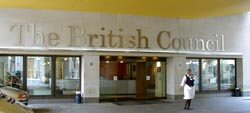Home | About the
Space Science Team | Before | During
| After | Student
Presentations | Visual Tour
Publications | More
Links and Resources | Site Map
Publications
Kolecki, Joseph, and Ruth Petersen, "Real World" Connections Through Videoconferences, NASA/TM 2001-211300, download at http://gltrs.grc.nasa.gov/cgi-bin/GLTRS/browse.pl?2001/TM-2001-211300.html
British Council Science Education Newsletter Publications

Ruth Petersen | Eric AlboneUK-Japan Young Scientists Working Together
JAPAN 2001 SCIENCE, CREATIVITY & THE YOUNG MIND WORKSHOP
Patron, The Rt Hon the Lord Jenkin of RodingDr Eric Albone, Clifton Scientific Trust, Bristol, and
Lawrence Williams, Holy Cross School, New Malden
The British Council Science Education Newsletter 155, December 2001This July, as part of the Japan 2001 Festival, sixty post-16 students from schools across Britain and Japan came together in Bristol to work for a week in small UK-Japan teams on a wide range of genuine open-ended science-related explorations that challenged their ingenuity and creativity.
This was the first time such a UK-Japan partnership had been attempted and was a resounding success in spite of all the difficulties of language. As one Japanese student wrote, "I could break the language wall".
In the process the students not only put their school knowledge to use and discovered something of the "scientist in themselves", but also by living and working together came to share and value each other's ways of thinking and working. The Workshop was over-subscribed by students in the UK and in Japan. In both countries, two thirds of the applications came from young women.
Ten Student Teams, led by top professionals, tackled challenges in the fields of Aeronautics, Archaeology, Chemistry, Earthquake Engineering, Environment, Ethics in Medicine, Space Science, Science through Theatre, Vulcanology and Wildlife Conservation. At the end of the week each Team gave a public presentation of its achievements. As Professor Colin Blakemore, FRS, commented following the public presentations:
"I was very struck, as anyone watching this would be, by the enthusiasm of the members of the teams, especially the relationships between the British and Japanese participants. I think it demonstrates very well how useful, practical and collaborative projects can be in learning. I am sure all of you agree that doing these projects together is a better way of learning about subjects, in some cases on very difficult subjects, than listening to a lecture or reading from a textbook."There is not space here to detail individual Team Projects, save to mention just one which provides powerful evidence of the potential of video conferencing in facilitating just these kinds of interaction in the future. This builds on work reported in previous Science Education Newsletters (Science, Creativity and the Young Mind, SEN, 138, 1998; Videoconference on aeronautics between the Holy Cross School UK and NASA, USA, SEN, 151, 2000; Technology connects science students to the "real world", SEN, 153, 2001).
Full Reports of the Workshop are in preparation and some information is also available on the Workshop Website at www.clifton-scientific.org/j2001.
Our Space Science Team, comprising students Toshiyuki Itai (Tsukuba Daigaku fuzoku Kotogakko), Rania Kashi (Cardinal Vaughan Memorial School, London), Akiro Nakamura (Kaisei Gakuen, Tokyo), Ryo Nakamura (Rikkyo Niiza High School, Tokyo), Lee Parsons (Hengrove School, Bristol) and Adriano Silva (Sir George Monoux Sixth Form College, Walthamstow), working on Martian vulcanology with scientists Dr Carsten Riedel, Stuart Stansfield and Professor Steve Sparks FRS, in Bristol University Department of Earth Sciences, was in daily communication via videoconferencing with Joseph Kolecki and his colleagues at the National Aeronautics and Space Administration (NASA) Glenn Learning Technologies Project, Cleveland, Ohio, US.Joe Kolecki at NASA began the week through a videoconference link with the students by raising questions concerning various competing theories about the probable formation of volcanoes on Mars. Of specific interest was whether the great Tharsis volcanoes might be the result of an ancient impact event of planetary proportions, vs whether plate tectonic movement, evidence for which was recently discovered by NASA's Mars Global Surveyor Spacecraft, might account for them. The groundbreaking ICT aspect of the work of the group was that each day, Joe talked with the students and their Bristol scientist mentors over an ISDN 2 video-link, and supported their work by email. On Monday, the problem was outlined, on Tuesday and Wednesday difficulties arising from the work were discussed "live" with Joe both over the video link and by email, and on Thursday afternoon, the students gave a formal presentation of their findings to Joe and to several visitors at NASA, this time over an ISDN 6 video-link, in advance of their public presentation on Friday to the Bristol audience.
The students used photographs of Mars from the NASA web site, communicated with Joe by email and by video-link, sent JPEGS of their work in progress, used a document camera to show NASA different aspects of their work, used spreadsheets to develop their calculations, word-processed their results; and prepared their final presentation using PowerPoint, with specially created graphics, including Japanese Kanji and animation.
The Space Science Team results were spectacular on every level and are soon to be published both on the Clifton Scientific Trust and NASA websites. As Ruth Petersen, Educational Coordinator, Learning Technologies Project at NASA Glenn Research Centre wrote following the Workshop;
During four videoconferencing connections between Joe Kolecki and the Space Science team, we witnessed real world science education at its finest... Special guests from NASA and the Center of Science and Industry (COSI) in Toledo, Ohio, all felt the excitement of the real life scientific investigation and were amazed at the students' initiative and hard work... The model demonstrates effective collaboration among diverse cultures, as well as the effective use of technology (ISDN videoconferencing, e-mail, data sharing, and the Internet) in the educational setting. More importantly, it demonstrates that, given an exciting challenge and necessary resources, young people will far exceed everyone's expectations!
The Workshop was supported by the Daiwa Anglo-Japanese Foundation, the Great Britain Sasakawa Foundation, and Japan 2001. Recruitment of British Students was undertaken in association with the University of Bristol Widening Participation Office, and recruitment of Japanese students was undertaken and funded by the Chemical Society of Japan; Council of Chemistry Education in association with the Society of Biological Sciences Education of Japan, the Physics Education Society of Japan, and the Japan Society of Earth Sciences Education. In addition to NASA and the University of Bristol other Workshop partners included Airbus UK, Bristol Zoo Gardens, Bristol City Museum, Connexions West of England, The Environment Agency, The Y Touring Theatre Company, The University of the West of England and colleagues from Holy Cross School, New Malden & The Rikkyo School, Horsham
The Workshop was endorsed by Dr Peter Briggs, Chief Executive, British Association for the Advancement of Science, Mr Stephen Cox, Executive Secretary, Royal Society and Mr Kunio Sato, Director, Japan Society for the Promotion of Science, London Liaison Office
Further Information from Dr Eric Albone, Director, Clifton Scientific Trust (charity 1020913), 49 Northumberland Road, Bristol, BS6 7BA, UK; (+44)-(0)117-924-7664; eric.albone@clifton-scientific.org
Web Related:
David.Mazza@grc.nasa.gov
Technology Related: Joseph.C.Kolecki@grc.nasa.gov
Responsible NASA Official:
Theresa M. Scott


